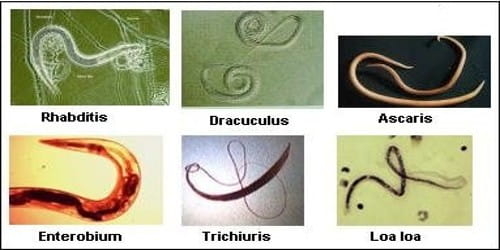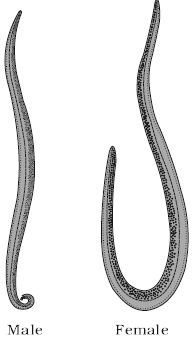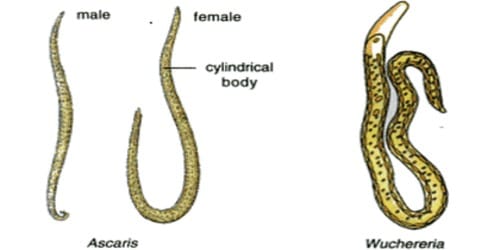The body of the Aschelminthes is circular in cross-section, hence, the name roundworms (Figure). It can be free-living or parasitic. They may be free-living, aquatic and terrestrial or parasitic in plants and animals. The free-living organisms are particularly abundant in soils and sediments and they feed on bacteria. Generally, they are marine or freshwater animals.
Some of these plant parasites and can cause disease in crops that are economically essential. The others can be found in animals and human beings.

Examples
- Ascaris lumbricoides – Round Worm,
- Enterobius vermicularis – Pinworm,
- Ancylostoma duodenale – Hookworm,
- Wuchereria bancrofti – Filarial worm,
- Loa loa – Eye Worm.

Fig: Phylum Aschelminthes (roundworms)
Roundworms have the organ-system level of body organization. They are bilaterally symmetrical, triploblastic and pseudocoelomate animals. The alimentary canal is complete with a well-developed muscular pharynx. An excretory tube removes body wastes from the body cavity through the excretory pore. Sexes are separate (dioecious), i.e., males and females are distinct. Often females are longer than males. Fertilization is internal and development may be direct (the young ones resemble the adult) or indirect.
Examples: Ascaris (Round Worm), Wuchereria (Filaria worm), Ancylostoma (Hookworm).
General Characteristics of Phylum Aschelminthes:
They are cylindrical, unsegmented and triploblastic animals commonly known as roundworms. They are mostly aquatic, but few are terrestrial. Some of the general characters of phylum Aschelminthes are as follows:
Body Form: The body is bilaterally symmetrical. They are called roundworms because they appear circular in cross-section. A distinct head is absent, but internal cephalization is present. However, the mouth is present in the anterior. They are un-segmented.
Body wall: It consists of a firm, non-living resistant cuticle, syncytial epidermis, and muscle layer. The body is covered with a thick cuticle that is flexible, non-living and made up of scleroprotein. The wall has epidermis, muscle layer and is covered by a cuticle.
Body cavity: The body cavity is called pseudocoel or pseudocoelom as it develops from the blastocoel of the embryo. They don’t have the power of regeneration. They are bilaterally symmetric.
Size: The body size of these organisms varies from microscopic to several centimeters in length.
Digestive Tract: Digestive system is complete with mouth and anus. The alimentary canal is complete with the muscular pharynx.
Skeletal, respiratory and circulatory systems are absent. Respiration occurs through the general body surface. Gaseous exchange in aerobic respiration occurs by diffusion through the body surface. The life cycle of these organisms is complicated.
Excretory System: The excretory system consists of gland cells, or of canals or of both. The excretory system has canals and gland-like. Amphids and papillae are the main sensory organs.
Sexes: Sexes are separate and are unisexual, exhibiting sexual dimorphism. They show sexual dimorphism (sexes are separate). Generally, they show sexual dimorphism; often females are longer than males. Fertilization is internal. Eggs are embryonated or mammilated with a chitinous shell. There is no asexual reproduction.
Development: Development may be direct or indirect. Fertilization is internal. During indirect development a larva is present. It may be with or without an intermediate host.











